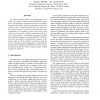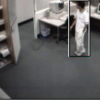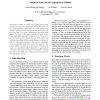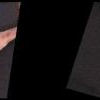CVPR
2003
IEEE
16 years 2 months ago
2003
IEEE
For object recognition under varying illumination conditions, we propose a method based on photometric alignment. The photometric alignment is known as a technique that models bot...
100
click to vote
CVPR
2003
IEEE
16 years 2 months ago
2003
IEEE
The aim of this paper is to find the best representation for the appearance of surfaces with Lambertian reflectance under varying illumination. Previous work using principal compo...
149
Voted
CVPR
2003
IEEE
16 years 2 months ago
2003
IEEE
Producing an accurate motion flow field is very difficult at motion boundaries. We present a novel, noniterative approach for segmentation from image motion, based on two voting p...
CVPR
2003
IEEE
16 years 2 months ago
2003
IEEE
This work explores a statistical basis for a process often described in computer vision: image segmentation by region merging following a particular order in the choice of regions...
CVPR
2003
IEEE
16 years 2 months ago
2003
IEEE
In this paper we explore object recognition in clutter. We test our object recognition techniques on Gimpy and EZGimpy, examples of visual CAPTCHAs. A CAPTCHA ("Completely Au...
113
click to vote
CVPR
2003
IEEE
16 years 2 months ago
2003
IEEE
The recognition of activities from sensory data is important in advanced surveillance systems to enable prediction of high-level goals and intentions of the target under surveilla...
102
click to vote
CVPR
2003
IEEE
16 years 2 months ago
2003
IEEE
Most cameras used in computer vision applications are still based on the pinhole principle inspired by our own eyes. It has been found though that this is not necessarily the opti...
CVPR
2003
IEEE
16 years 2 months ago
2003
IEEE
We present a method for online rigid object tracking using an adaptive view-based appearance model. When the object's pose trajectory crosses itself, our tracker has bounded ...
CVPR
2003
IEEE
16 years 2 months ago
2003
IEEE
It is now common practice in machine vision to define the variability in an object's appearance in a factored manner, as a combination of shape and texture transformations. I...
100
Voted
CVPR
2003
IEEE
16 years 2 months ago
2003
IEEE
Video-based recognition and prediction of a temporally extended activity can benefit from a detailed description of high-level expectations about the activity. Stochastic grammars...





